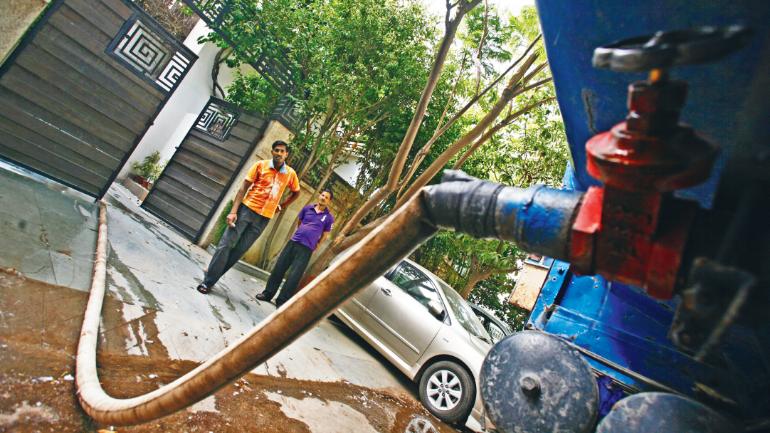|
Picture this scenario which is now becoming more & more common in cities. Your Apartment Complex is suddenly experiencing water shortage. Things had been going fine until now & throughout the 18 months you have been living there. You were able to get water 24 hours a day, 7 days a week. Looking back....it feels like only yesterday.....when you had just moved into your beautiful dream apartment finally. Before moving, and before signing the dotted line, you had casually thrown the question at the builder about the water, after being mesmerised by the design, location and price of the Apartment. And he had confidently told you about this "borewell" on site which yields good quantity of water. And you did not have a reason to probe any further. Water is the last thing you want to be bothered about. That's right! Most of us when we go shopping for our dream home, the last thing we think about is water amongst so many other priority considerations - proximity to kids' school, commute to our workplaces, proximity to shopping centres and markets. Water? ..Surely someone would have taken care of it, right? That is how it has always been...'someone' has always taken care of 'our' water. How would a builder build such a large and beautiful project if they didn't have access to water. Of course, water would be surely 'there' When you moved, there were 22 flats that were occupied. End of 'flashback' ...cut to today's scene....18 months since you moved to this Apartment. Today you have 128 flats occupied which make up 80% of the Apartment complex. So, in the last 18 months, the occupancy has gone up nearly 5 times. So has the demand for water. Now, the borewell yield is no longer able to cope with the increase in demand. In technical language, your Apartment is now experiencing a 'water deficit' which is the root cause of the water stress that water users in your Apartment are feeling. Water deficit is simply an imbalance between existing water demand and available water supply. Which means that the deficit can be managed by managing both - existing water demand as well as available water supply. Correct? But, what is a typical human response to a water deficit situation? As soon as we experience the water stress in the form of taps running out of water after running for few short hours, our immediate response is we need to get 'more' water from somewhere. That somewhere could be a new borewell or water purchased using a water tanker. We never ever stop to think what could we 'do' to manage our water demand. Managing demand? Why? How? Why? Because what if the water use by all residents in the Apartment was such that it was actually wasteful and not efficient? You see....water is no different to money. If you dont keep track of your expenses....there is a good chance you can blow your budget and your expenses start overtaking your income landing you in debt. The only difference between water & money is. We can easily count money. But counting water? Who does that? Nobody counts water....although we all speak of 'every drop counts'. If you were to start counting your water....to ask yourself how much water are you receiving, how much water are you spending & where, you will be surprised to learn that typically anywhere between 30 to 50% water use can be 'saved' by making simple changes to the hardware of water fixtures and water use behaviour. Just think about it for a moment -your Apartment can be supplied with 'water' you already have by simply cutting down & eliminating your wasteful inefficient water uses. As it will immediately make available 30 to 50% of water you already have!! This, my dear, is called 'demand side' thinking..... Demand side thinking is when you hold back your urge to dig another borewell and purchase water by ordering water tankers....until you have counted water use in your Apartment and found ways to first fix your wasteful water consumption. Demand side thinking results in actions that are low on cost and big on savings. Capturing the low hanging fruits before you start investing in getting new supplies. Now the question is - how do you go about counting the water use in your Apartment Complex? Do I need some water counting device? Is it possible to count our water use to know how efficient or wasteful our water consumption is? There is a short answer and a long answer to this question. The short answer is - litres of water use per person per day (LPPD in short) is a good indicator of water use efficiency. Using the info you have on your average daily water consumption at the Apartment Complex level, and total number of residents, you can estimate the LPPD. More than 200 LPPD would be considered highly water inefficient, Those with LPPD less than 200 but more than 140 would be considered moderately water inefficient. Water efficient apartments would have less than 140 LPPD or less. The long answer involves telling you about counting water in a way that allows you to get into the depth that helps you figure out all the hotspots in the building which is contributing to the inefficiency & wasteful water use. You can investigate that by doing a Water Audit. I will cover more about water audit, in my next blog. In the meantime, please share in the comment box, what is the LPPD of your Apartment Building or your own individual house. How water efficient are you? Begin your water conservation journey by doing this basic counting. Learning to count your drops is the first step to make every drop of your water count in your journey to creating a water-abundant future for yourself.
0 Comments
|
Urban Water DoctorUrban Water Doctor is focused on helping residential water users ArchivesCategories |

 RSS Feed
RSS Feed
